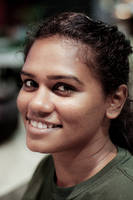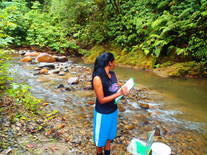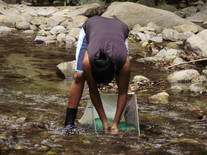Bindiya Rashni
 Degree: Master of Science in Marine Science
Degree: Master of Science in Marine Science
Title: Effect of catchment forest cover on macroinvertebrate community structure in Streams of Fiji
Principal Supervisor: Prof. William Aalbersberg
Status: Completed
Abstract:
This research aimed at investigating the health of streams draining catchments with varying percentage forest cover in order to better understand the effect that the alteration of catchment forest cover has on the stream macroinvertebrate fauna.
To achieve the aim of the research, three objectives were designed. These comprised of assessing (a) the biotic parameters (macroinvertebrate community structure) and (b) the abiotic parameters (water quality and in-stream habitat features) of stream health and then (c) examining the relationships between catchment forest cover and biotic and abiotic parameters. Six streams (three in each of two catchments) of Ra and Kadavu provinces were sampled for macroinvertebrates, water quality and habitat data during the dry and wet seasons. Macroinvertebrate samples were collected using a Surber sampler and a kick-net. Percentage forest cover of the catchment was determined using Berkeley Image Segmentation and ArcGIS 10.x program. The biotic and abiotic data were analyzed using both univariate and multivariate statistical methods.
A total of 35,334 individual macroinvertebrates were collected and identified to the lowest possible taxonomical level. A total of 140 distinct taxa in 53 families were collected and an additional new record of 14 aquatic families in the phylum Insecta for Fiji was documented. The macroinvertebrate abundance, species richness and diversity graphs did not show any apparent relationship with catchment forest cover.
The results of PCO (Principal Coordinate Analysis) analyses associating abiotic variables with macroinvertebrate community assemblage in Kadavu streams showed that ‘percent forested’ was the factor that explained the most variation in the macroinvertebrate community. The results of PCO analyses associating abiotic variables with macroinvertebrate community assemblage in Ra streams showed that the factors, ‘percent forested’, canopy cover, temperature and conductivity explained the most variation in the macroinvertebrate community.
The PCO analyses also identified several species that are strongly associated with either highly forested or poorly forested catchments, thus making them potential candidates for indicators of watershed health/intactness. The species associated with highly xvii forested catchment streams were a finger-net caddisfly Chimarra sp. A, the atyid shrimps Atyoida pilipes and Atyopsis spinipes, and the neritid gastropods Neritilia rubida, Septaria sanguisuga, and Neritina squamaepicta. The species associated with the least forested catchment streams were a clinging mayfly nymph Pseudocloeon sp. and the net spinning caddisfly larvae Abacaria fijiana.
The Distance Based Linear Modeling (DistLM) results showed that the best solution single variable model highlighted that the predictor percent forested had the highest R2 correlation value (7.6197E-2) and was therefore the single factor that explained the greatest proportion of variance in the macroinvertebrate assemblage.
The combined results of the species richness graphs, the PCO analyses and the DistLM analysis when taken in their totality show that streams draining highly forested catchments have more ‘sediment sensitive’ species in comparison to streams draining less forested catchments. This is a pioneering study on a catchment-scale level effect and corresponding ecological response in Fiji streams. It is hoped that the information gathered through the current study will be used to facilitate development of appropriate stream health and watershed health indicators and contribute to watershed management in Fiji.

